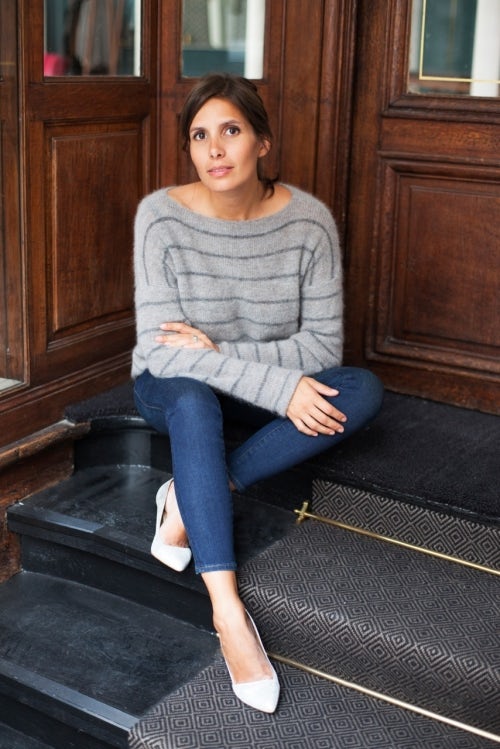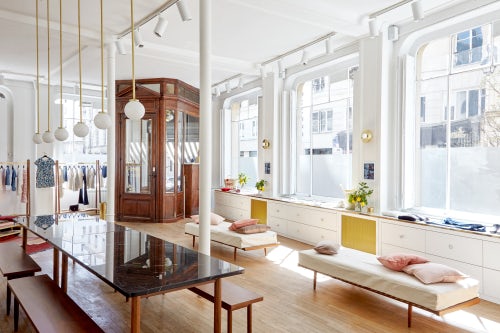Scaling Sézane, France’s First Online Fashion BrandA Story by Etrade Supply Smartphone PartsIn 2004, when Morgane Sézalory began selling her sister’s cast-off vintage clothes on eBay, “No one was confident that it could be a business, more than a hobby,” she says.In 2004, when Morgane Sézalory began selling her sister’s cast-off vintage clothes on eBay, “No one was confident that it could be a business, more than a hobby,” she says. This didn’t dissuade Sézalory. Having quit high school in her final year, she flogged vintage fashion on eBay for four years, before, with no business training or design experience, she launched her own website, Les Composantes, where she uploaded and sold 100 vintage finds a month. In 2013, Sézalory challenged conventional wisdom again. By this time, fashion retail had moved online �" Net-a-Porter and Yoox had been in business for over a decade, MatchesFashion.com had gone online in 2006, Farfetch launched in 2007, and most large fashion labels had launched e-commerce in some form. In the US, start-ups like Warby Parker, Bonobos and Everlane were also pioneering a new model �" the online-only fashion brand �" while Nasty Gal had grown out of founder Sophia Amoruso's eBay store to become a standalone website and brand.  photos:http://www.marieprom.co.uk/graduation-dresses Morgane Sézalory | Source: CourtesyBut France was lagging behind. “It was [believed that] a brand has to have a shop,” says Sézalory. “No one could believe that I was starting a brand online.” Undeterred, she relaunched Les Composantes under the name Sézane �" a contraction of her first and last name �" and made the pivot from e-tailer to brand, working with a few European factories to produce feminine, French-inspired designs �" easy day-to-night dresses, loose chic trousers and subtle blouses with details like a button-down back or sailor-esque buttons on the shoulders. Corentin Petit, co-founder of French men’s label Balibaris, joined the venture as Sézalory’s business partner a few months before the relaunch, and the two managed everything together �" including packaging and shipping everything out of Sézalory’s apartment. France’s first online-only fashion brand was born. “It was obvious,” says Sézalory, who is now 31. “I didn’t have the cost of a retailer and there was no one between me and the consumer. It was great quality and I don’t think we had any competition for product at that price.” Indeed, this business model has become tried and tested. Warby Parker and Bonobos have both hit $100 million in revenues �" a figure that Everlane expects to reach this year, according to market sources. Like Sézane, these businesses work closely with their factories and sell direct-to-consumer, cutting out the middleman and the overheads of operating physical stores. They pass on this saving to the consumer and sell their goods with lesser mark-ups, to hit low prices for high-quality fashion. We never explain the price �" the consumer doesn’t think about the price, it’s about desire “We had no experience making clothes so we had to find really good quality factories where we could visit them quickly. The most important thing for us is for us to go there, to have a very strong relationship with the factory,” says Sézalory. “We make shoes in factories who work with luxury brands but because of our business model we can have a different price.” Shoes �" which include wear-anywhere sandals, espadrilles and heels in natural tones, as well as sneakers �" are Sézane’s top-selling category. More than two-thirds of Sézane’s collections are manufactured in Europe, in factories who also work for brands including Chloe, Lanvin and Vetements (the rest is made in locations including China and India). “It’s not cheap, but we basically have lower gross margins than anyone in our range of prices,” explains Petit. Heeled leather sandals cost around €150 (about $165), while dresses range from €85 ($94) to €230 ($253). If you add the cost of operating a physical store, he says, “you get very high prices and then you have to discount or do promotions. We don’t do that.” However, Sézalory rejects the comparison with brands like Everlane, which focus on basics like t-shirts. “For each collection, there are 200 fabrics that we use. It’s not plain, it’s fashion,” she says. Transparent pricing �" a point of differentiation for Everlane, which reveals its mark-ups to consumers �" is also not part of Sézane’s approach. “We never explain the price �" when the consumer goes toIsabel Marant, Carven, she doesn’t think about the price, it’s about desire,” says Sézalory. Sézane produces two seasonal collections a year, as well as smaller monthlycapsule collections. This short product cycle generates newness for consumers and avoids leftover stock (Sézane does not discount, and items on the site regularly sell out). “That helps us where a lot of clothing companies have a cash problem,” says Petit. “We don’t wait for payment from anyone.” Sézalory declined to provide current revenues, but says Sézane has no outside investors and has always been profitable �" a fact she puts down to control. The company manages its shipping and logistics in-house, from a warehouse in West France, and doesn’t sell anywhere except Sézane.com, despite “lot of requests from department stores,” says Petit. The Internet is a magical format �" we already have consumers all over the world, without doing anything. However, the brand has tapped collaborations as a means of gaining both sales and exposure in new markets. Since 2014, Sézane has launched three sell-out collections with Madewell (designed by Sézane and produced by Madewell), with a fourth coming out in October. The relationship began when Madewell art director Alice Bucaille, who is French, wanted Sézane’s sold out "La Superbe" sweater, so Sézalory arranged to meet her in New York to give her one. “Madewell’s lifestyle idea of the brand is not so far [from Sézane]�" but different, because it is American and very casual. We added some French chic,” says Sézalory of Madewell’s relaxed wardrobe staples. The two brands also sit at a similar price point �" their first collaboration was priced from $85 to $315. The partnership has boosted Sézane’s exposure in the US �" the business launched in the US and UK in October last year, and out of 10,000 to 20,000 orders a month, “We have more than 1,000 orders a month from New York, without doing any communications [there],” says Sézalory. France still makes up 80 percent of overall sales, followed by the UK, US and Belgium.  Sézane's Paris apartment | Source: CourtesyLike digital-first brands Warby Parker and Bonobos, Sézane has also dipped its toe into physical retail. Last October, Sézane opened the “apartment” �" a 400 square metre “connected store” in Paris where customers can try on items and then order them online �" enabling the business to avoid the inventory management required with a traditional shop. A small selection of stationery and homeware is available to buy in store, and the building serves as a space for events and includes a private velvet seated cinema. A flashy physical store “is not something we needed,” says Sézalory. The building is tucked away from Paris’ main shopping streets on Rue Saint-Fiacre, and previously served as Sézane’s offices, until their neighbours moved out and they joined the two locations into one for “very low rent,” she says. “The apartment is an image project, a communications cost,” adds Petit. Now, the plan is international expansion. Today, Sézane has a team of 50 people �" until 2014, it was just Petit and Sézalory. More physical retail is in the pipeline too. Sézane is currently looking for a location to launch an apartment in London this year, with a New York store to follow in 2017. Further collaborations are also on the cards �" one with Parisian department store Le Bon Marché in September, and another in March with Holiday, a high-end biannual magazine and e-commerce store by creative design studio Atelier Franck Durand. However, some things aren’t changing �" Sézane has no immediate plans to seek investment and, while collaborations with US-based brands will help up its exposure in new markets, the company has no plans to start advertising. “It could seem a bit naïve but we really do the communication through the product,” says Petit. “The Internet is a magical format �" we already have consumers all over the world, without doing anything,” agrees Sézalory. “Something was missing in fashion. The Internet offered the possibilities for me to fulfil this.” Read more:http://www.marieprom.co.uk/celebrity-dresses-red-carpet-dresses © 2016 Etrade Supply Smartphone Parts |
Stats
284 Views
Added on July 22, 2016 Last Updated on July 22, 2016 Tags: Scaling Sézane, fashion, marieprom, dress AuthorEtrade Supply Smartphone PartsHong Kong, ChinaAboutEtrade Supply is mainly for business of mobile phone repair parts like LCD display screen and digitizer or other small parts, mobile phone accessories and repair tools. more..Writing |

 Flag Writing
Flag Writing